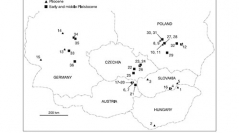

 Geodiversitas
29 (2) - Pages 297-320
Geodiversitas
29 (2) - Pages 297-320Fossil evidence of extant amphibian and reptile species is relatively well documented in the Pleistocene record. However, the early Pliocene records of extant species are much more scarce and their Miocene (or even the early Miocene) records are extremely rare. The late Pliocene Central European assemblages contain several extinct forms that survived from the late Miocene. The extinction event at the early/late Pliocene boundary (MN 15/MN 16) distinctively affected especially the southern part of Central Europe (the last occurrences of Albanerpeton pannonicus, Mertensiella mera, and Latonia gigantea). Several other taxa died out during MN 16 zone. This Pliocene extinction is a result of deterioration of climatic conditions with the process of aridization playing, most probably, the key role. Because numerous taxa became extinct long before the beginning of the Pleistocene during the MN 15 and MN 16 zones, the Pliocene/Pleistocene transition (c. 1.8 Ma) is not reflected in the evolution of Central European herpetological assemblages. Herpetological assemblages fundamentally changed during the terminal part of the early Biharian (early Pleistocene) when several Pliocene and early Biharian representatives became extinct. In the late Biharian herpetological assemblages no extant “Mediterranean” taxa have been reported from Central European localities situated north of Austria. “Mediterranean” amphibian and reptile species which receded to refugia in the Balkan Peninsula during the first late Biharian cold cycles were unable to recolonize the wide areas of Europe during the intensive but short warm climatic cycles.
Amphiba, Reptilia, palaeoecology, climate, Pliocene, Pleistocene, Central Europe